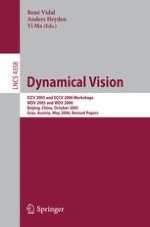Classical multiple-view geometry studies the reconstruction of a static scene - served by a rigidly moving camera. However, in many real-world applications the scene may undergo much more complex dynamical changes. For instance, the scene may consist of multiple moving objects (e.g., a tra?c scene) or arti- lated motions (e.g., a walking human) or even non-rigid dynamics (e.g., smoke, ?re, or a waterfall). In addition, some applications may require interaction with the scene through a dynamical system (e.g., vision-guided robot navigation and coordination). To study the problem of reconstructing dynamical scenes, many new al- braic, geometric, statistical, and computational tools have recently emerged in computer vision, computer graphics, image processing, and vision-based c- trol. The goal of the International Workshop on Dynamical Vision (WDV) is to converge di?erent aspects of the research on dynamical vision and to identify common mathematical problems, models, and methods for future research in this emerging and active area.
